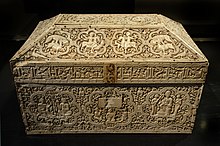Leyre Casket

The Leyre Casket (Arqueta de Leyre, Museo de Navarra inventory number 1360-B, also known as the Leire Casket, Pamplona Casket) is one of the jewels of Hispano-Arab Islamic art. It is a casket or reliquary made of elephant ivory which was made in 1004/5 in the
Form

The casket takes the following form:[1]: 214
- Shape: rectangular, with a truncated pyramidal lid.
- Material: elephant ivory and silver.
- Dimensions, centimetres: 23.6 (height) x 38.4 (width) x 23.7 (depth)
The casket is remarkable for its profusion of detail and the finesse of its execution. It is inscribed with sculptures depicting the Abrahamic God, as well as gazelles, eagles, lions, a unicorn and antelopes in a hunting scene. A
In the description of Henry Luttikhuizen,
This precious container is covered with elaborate ornament and includes twenty-one courtly scenes in octagonal lobed medallions. The enthroned caliph is pictured between attendants offering him perfumes and musical entertainment. Feast celebrations, lion and elephant hunts are also represented. These scenes as well as the profusion of vegetal and floral motifs reinforce connotations of a princely paradise.[2]
Inscriptions
The most prominent inscription on the casket is an Arabic text in foliated Kufic script with bevelled staves running around the edge of the lid. This reads
In the name of God, God be blessed, prosperity, happiness and attainment of expectations from pious works, and respite from the appointed time of death to the hājib Sayf al-Dawla, ‘Abd al-Malik, son of al-Mansūr, may God grant him success. [This is part of it] from that which was ordered to be made under the supervision of the chief page Zuhayr ibn Muhammad al-ʿAmirī, his servant in the year three hundred and ninety-five.[3]
There are a number of much smaller incised inscriptions, giving the names of the craftsmen who made the casket; their names have been interpreted as likely to have been names given to slaves:[3][4]: 234
- Inside the lid: 'ʿamal faraj maʿa talāmidhihi' ('the work of Faraj, with his apprentices')
- Right-hand side of the lid, on the calf of the right-hand huntsman: 'ʿamal faraj' ('the work of Faraj')
- Front (on the throne-platform in the right-hand cartouche): 'ʿamal misbāh' ('the work of Misbāh')
- Back (on the hunter's shield, in the medallion in the centre): 'ʿamal khayr' ('the work of Kayr') and 'in the name of God, God be blessed, felicity and prosperity'.
- Back (in the medallion on the left-hand side, on the horses' hindquarters): '... md ʿāmir[ī]'
- Right-hand side (on the hindquarters of the left-hand deer in the right-hand medallion): 'ʿamal saʿād' ('the work of Saʿād')
- Left-hand side on the hindquarters of the right-hand deer in the left-hand medallion: 'ʿamal rashīd' ('the work of Rashīd')
Origin and history


The casket is the largest example of twenty-nine ivories known to have been manufactured for Muslim patrons between c. 950 and 1050 in the Iberian peninsula, and artistically one of the most impressive.[5]: 375 [4]: 234 The casket was carved during the Caliphate of Cordoba in the Caliphal workshop of either Madinat al-Zahra, the palace-city built by Abd ar-Rahman III, or Madinat al-Zahira, the rival palace built by Almanzor.[6] The year of production is given as 395 AH (1004/1005 CE).[1]: 214–15 The casket was produced for ʿAbd al-Malik al-Muẓaffar, political and military leader of the caliphate from 1002 to 1008, during the reign of Hisham II. ʿAbd al-Malik is best known for being the son of Almanzor, vizier of Hisham II, but also military leader and strong politician of the caliphate.
At some point, as Christian kingdoms
The casket was later held by the
: 215See also
References
- ^ a b c d e f Julie Harris, 'Muslim Ivories in Christian Hands: The Leire Casket in Context', Art History, 18 (1995), 213-21.
- ^ Henry Luttikhuizen, 'The Place of the Sacred: Islamic and Christian Visual Cultures in Medieval Spain', Christian Scholar's Review, Holland, 34 (2005), 463-85 (pp. 472-73).
- ^ a b 'Leyre Casket', قنطرة quantara: Mediterranean Heritage.
- ^ ISBN 9781107092419.
- Sheila S. Blair, 'Ivories and Inscriptions from Islamic Spain', Source: Oriente Moderno, new series, 23 (2004), 375-86.
- ISBN 0870996371.
- .
Further reading
- John Beckwith, Caskets from Cordoba (London: H.M. Stationery Office, 1960) [repr. in Studies in Byzantine and Medieval Western Art (London: 1989), pp. 194–265]
- Ernst Kühnel, Die Islamischen Elfenbeinskulpturen VIII-XIII Jahrhundert (Berlin: 1971)
- Cynthia Robinson, 'Love in the Time of Fitna: "Courtliness" and the "Pamplona" Casket', in Revisiting al-Andalus: Perspectives on the Material Culture of Islamic Iberia and Beyond, ed. by Glaire Anderson and Mariam Rosser-Owen, The Medieval and Early Modern Iberian World, 34 (Leiden: Brill, 2007), pp. 99–112, ISBN 9789047422068
- Record at Collectiones en Red
